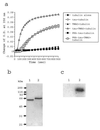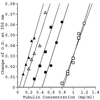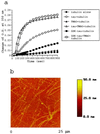Phosphorylated tau can promote tubulin assembly
- PMID: 10449722
- PMCID: PMC22238
- DOI: 10.1073/pnas.96.17.9503
Phosphorylated tau can promote tubulin assembly
Abstract
Phosphorylation can affect the function of microtubule-associated protein tau. Here, the human brain tau with 441 amino acids was phosphorylated by cyclic-AMP-dependent protein kinase (PKA) or glycogen synthase kinase-3beta. PKA-phosphorylated tau (2.7 mol phosphates/mol) does not promote tubulin assembly as judged by spectrophotometric and atomic force microscopy measurements, unless trimethylamine N-oxide (TMAO), a natural occurring osmolyte, is included in these assays. TMAO is also found to promote tubulin assembly of glycogen synthase kinase-3beta-phosphorylated tau (1.6 mol phosphates/mol). TMAO does not act by causing a chemical dephosphorylation of phosphorylated tau, but it acts to overcome the functional deficit caused by phosphorylation. PKA-phosphorylated tau binds to tubulin in the presence of TMAO and lowers the critical concentration of tubulin needed for assembly. From these data, we conclude that PKA-phosphorylated tau retains the ability to bind tubulin and promote tubulin assembly. TMAO is required, however, to sensitize the reaction. Possible uses of TMAO in relation to studies of tubulin assembly in vitro, in intact cells, and in relation to Alzheimer's disease are presented in this report.
Figures




Similar articles
-
Phosphorylation of tau by glycogen synthase kinase-3 beta in intact mammalian cells: the effects on the organization and stability of microtubules.Neuroscience. 1996 Aug;73(4):1145-57. doi: 10.1016/0306-4522(96)00126-1. Neuroscience. 1996. PMID: 8809831
-
Glycogen synthase kinase 3 phosphorylates recombinant human tau protein at serine-262 in the presence of heparin (or tubulin).FEBS Lett. 1995 Sep 18;372(1):65-8. doi: 10.1016/0014-5793(95)00934-2. FEBS Lett. 1995. PMID: 7556645
-
Phosphorylation of tau by glycogen synthase kinase 3beta affects the ability of tau to promote microtubule self-assembly.Biochem J. 1997 May 1;323 ( Pt 3)(Pt 3):741-7. doi: 10.1042/bj3230741. Biochem J. 1997. PMID: 9169608 Free PMC article.
-
Dephosphorylation of microtubule proteins by brain protein phosphatases 1 and 2A, and its effect on microtubule assembly.J Neurochem. 1988 May;50(5):1614-23. doi: 10.1111/j.1471-4159.1988.tb03051.x. J Neurochem. 1988. PMID: 2834518
-
Phosphorylation of tau by glycogen synthase kinase 3beta in intact mammalian cells influences the stability of microtubules.Neurosci Lett. 2001 Oct 26;312(3):141-4. doi: 10.1016/s0304-3940(01)02206-6. Neurosci Lett. 2001. PMID: 11602330
Cited by
-
Tau function and dysfunction in neurons: its role in neurodegenerative disorders.Mol Neurobiol. 2002 Jun;25(3):213-31. doi: 10.1385/MN:25:3:213. Mol Neurobiol. 2002. PMID: 12109872 Review.
-
Role of APC and DNA mismatch repair genes in the development of colorectal cancers.Mol Cancer. 2003 Dec 12;2:41. doi: 10.1186/1476-4598-2-41. Mol Cancer. 2003. PMID: 14672538 Free PMC article. Review.
-
Prion-Like Propagation of Post-Translationally Modified Tau in Alzheimer's Disease: A Hypothesis.J Mol Neurosci. 2018 Aug;65(4):480-490. doi: 10.1007/s12031-018-1111-5. Epub 2018 Jul 7. J Mol Neurosci. 2018. PMID: 29982964 Review.
-
Quantitative chemoproteomics reveals dopamine's protective modification of Tau.Nat Chem Biol. 2025 Feb 20. doi: 10.1038/s41589-025-01849-9. Online ahead of print. Nat Chem Biol. 2025. PMID: 39979588
-
Absence of a Role for Phosphorylation in the Tau Pathology of Alzheimer's Disease.Biomolecules. 2016 Apr 8;6(2):19. doi: 10.3390/biom6020019. Biomolecules. 2016. PMID: 27070645 Free PMC article.
References
-
- Iqbal K, Grundke-Iqbal I, Zaidi T, Merz P A, Wen G Y, Shaikh S S, Wisniewski H M, Alzfuzoff I, Winblad B. Lancet. 1986;2:421–426. - PubMed
-
- Mandelkow E-M, Mandelkow E. Trends Biochem Sci. 1993;18:480–483. - PubMed
-
- Goedert M. Trends Neurosci. 1993;16:460–465. - PubMed
-
- Schneider A, Biernat J, von Bergen M, Mandelkow E, Mandelkow E-M. Biochemistry. 1999;38:3549–3558. - PubMed
Publication types
MeSH terms
Substances
LinkOut - more resources
Full Text Sources

